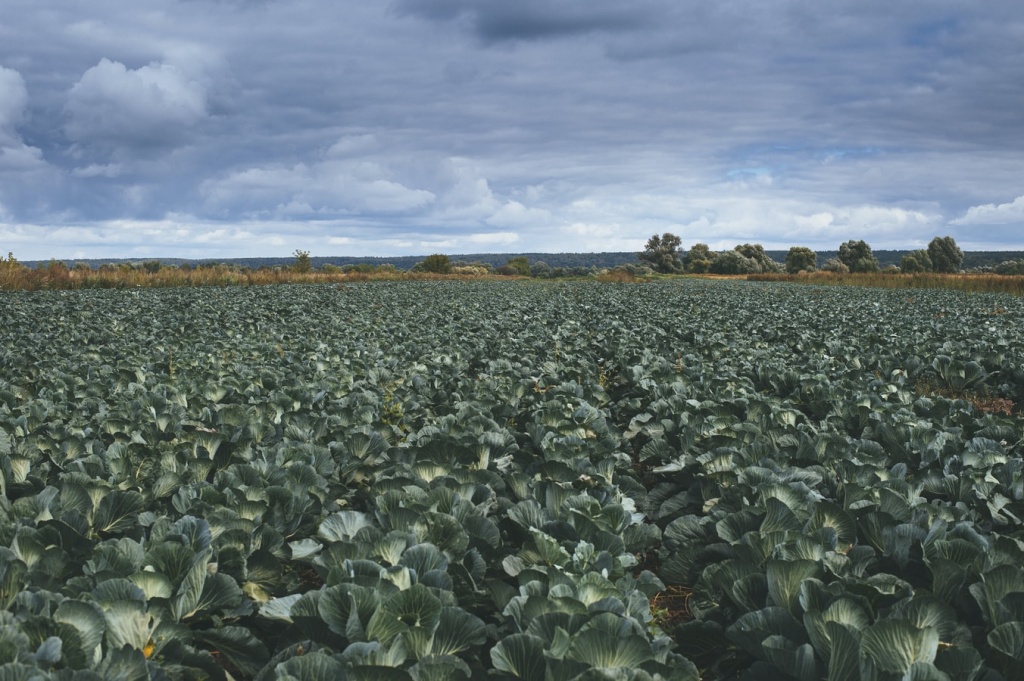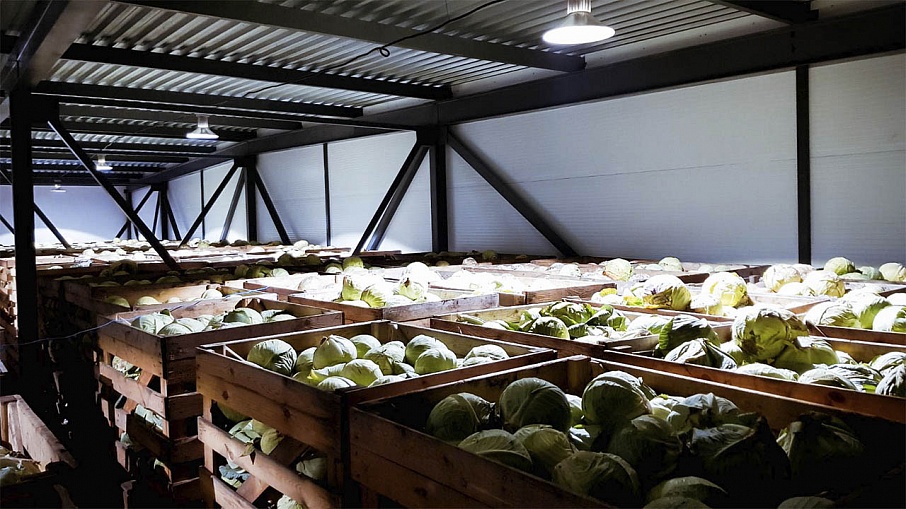Features of the technology of growing white cabbage
17.02.2021 | Cabbage
So, dear lovers of cabbage. This material is about the technology of growing and long-term storage of white cabbage - one of the most widespread and oldest vegetable crops.
After all, they began to grow cabbage in Russia in the 9th century. The climate of Russia approached the cold-resistant and moisture-loving cabbage, and soon white cabbage became one of the main products on the table, remaining the leading vegetable crop in terms of the number of sown areas in Russia to this day. But despite the unpretentiousness and resistance to climatic conditions, in order to grow and maintain a crop, it is required to maintain certain conditions, which will be discussed below.
Field preparation
We will not tire of repeating that high-quality storage of the crop begins in the field, with crop rotation, soil preparation and care for the crop. The soil requires loosening (or chiseling) 1-2 meters deep every five years.
The plowing of the field is carried out in the fall with the help of special reversible plows: the surface of the ground is leveled to close up the plant residues. For sowing white cabbage, give preference to light loamy and sandy loam soil.
Sandy loam and light loamy soils are the best for early cabbage. Peat and heavy loamy floodplain soils are not suitable. For late cabbage, choose sod-podzolic soils or floodplain highly fertile soils. Sour or acidic soils are absolutely unsuitable for growing late cabbage.
The first step is to study the “herbicidal history” of the field. In most places in Russia, the best predecessors of cabbage are carrots, early potatoes, onions, tomatoes, cucumbers.
In order for the development of the crop to be stable, fertilize the soil with mineral fertilizers: potassium (3.4 parts), nitrogen (2.8 parts) and phosphorus (1 part). During the plowing period, use fertilizers in which potassium and phosphorus prevail - this will help in obtaining a crop and saturating the cabbage with the necessary useful elements.
If you fertilize cabbage with manure, this will provide half of the rate of phosphorus consumption per year, as well as about seventy percent of the annual rate of potassium and twenty percent of nitrogen.
Methods for growing white cabbage

Two methods are used to grow cabbage crops: seedling (when the cabbage grows in greenhouses) and seedless (cabbage grows in open ground).
Growing cabbage in greenhouses
Before sowing seeds, the greenhouse soil must be treated with herbicides: it is recommended to use Butisan (40%) in a dosage of 0.4 liters per hectare of land. Seeds are covered no deeper than 1 centimeter. Before the first shoots begin to appear, the soil in the greenhouse must be regularly moistened, maintaining the temperature +23 - +25 degrees. After the seedlings sprout, watering stops. This will allow the cabbage root system to harden and sink into the soil.
Seedlings need to maintain a temperature regime of +12 to +14 degrees during the day and from +8 to +10 degrees at night. Three days before planting, the soil of the field is treated with the Antara systemic insecticide: from 0.3 kilograms per 150 liters of water (taking into account the solution consumption of 1 liter per square meter of seedlings).
Growing cabbage outdoors
The advantage of the seedless method is that under these growing conditions, a stable root system develops in the cabbage, which helps the plant to "tolerate" the lack of moisture. The cost of cabbage with this growing method also becomes lower.
Give preference to soils with high fertility and light grain size distribution. Use the dedicated Agricola planter for accurate seeding. The disadvantages of a seedless cabbage growing method are in a high risk of damage from phytopathogenic microorganisms.
Preparations for the protection of white cabbage
 Herbicides
Herbicides
Before milling the soil, a week before planting the seedlings, a soil herbicide stomp is applied to a depth of 3-5 cm. For any soil, only 1.5-2.0 l / ha is enough.
Treflan. Good use 3 days before planting seedlings (2-2.5 l / ha).
Dual Gold. It is applied 3 days after planting the seedlings, it is applied (1.5 l / ha). You can try an analogue of Butizan 400 (0.5 l / ha).
When treating row spacings with continuous herbicides, it is recommended to use "Stekete" cultivators, which cover the cabbage with protective covers.
Fungicides
Phytolavin 300. To avoid bacteriosis and black leg, seedlings can be treated in the phase of 2-3 leaves with a 0.2% solution.
Planriz. During the growing season, as soon as the first signs of the disease appear, a 0.1% solution is applied. Consumption is approximately 400 l / ha.
Insecticides
Aktara. The drug copes well with cruciferous flea beetles and cabbage flies. Watering seedlings in cassettes a couple of days before planting in the field (0.3 kg per 40 thousand seedlings) reliably protects cabbage from these pests for a month. Thanks to Aktar, the seedless method became a production one, saving the harvest and showing systematic activity.
Decis, fitoverm. Effective against leaf-eating pests such as cabbage moth.
Features of caring for cabbage during the growing season
It must be remembered that cabbage tolerates drought more easily than waterlogging, therefore, exclude waterlogging of fields.
A 1.5% solution of potassium fertilizers will help well to accelerate the ripening of the crop, increasing the outflow of nutrients from cabbage leaves to the head of cabbage. Potassium chloride solution (400 l / ha) is suitable for prophylaxis against diseases.
Cleaning
Early cabbage is considered ripe when its weight has reached 1kg, the heads of cabbage have gained density, and the lower leaves began to turn yellow. It is better not to overexpose the harvest, as the heads of cabbage overripe, burst and become unsuitable for storage.
Harvesting is done in dry weather. The head of cabbage is cut with a special knife, leaving a stump of 1 cm. This avoids contamination and mechanical damage to the cabbage. Each head of cabbage is stacked with the cut upwards so that soil infection does not enter the vegetable through the cut.
It is not recommended to leave cabbage on the field before frost, because if the air temperature drops below 6 ° C, the crop will freeze and will not be stored.
Storing white cabbage in a vegetable store

The technology of long-term storage of white cabbage in a vegetable store involves the creation and maintenance of the following microclimatic conditions:
- Storage temperature from -1 to +1 degrees ° C.
- Air humidity in the storage chamber 95%
- Indicators of carbon dioxide concentration, not more than 5%. (Use CO2 removal systems)
Storing cabbage in containers is much more efficient than storing in bulk. In containers, the integrity of the heads of cabbage and their freshness are better preserved, due to the uniform ventilation of the air. During harvesting, cabbage should be placed in a container in such a way that the stalk has access to fresh air.
We recommend storing up to 1500 tons of crops in one chamber.
When using a refrigeration system, the cabbage crop can be stored for a whole year, when using an active air ventilation system - until April.
Do you want more information about technologies for storing vegetables and fruits?
And for any questions that arise, call +74952293903 or +79857799713 and write to info@agrovent.com.



